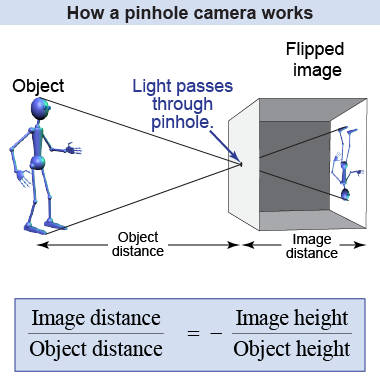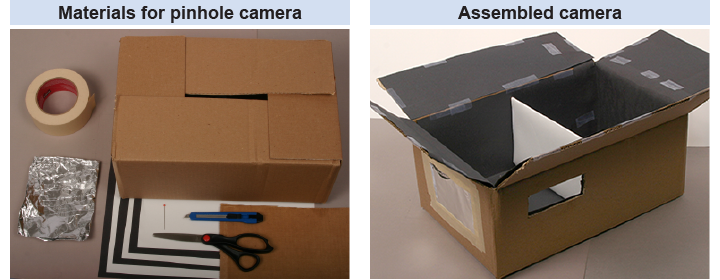|
In this field investigation you will design a pinhole camera that produces an image of the Sun at least 5 mm in diameter. You will use the pinhole camera to observe features on the Sun. Note that your eyes can be damaged by looking directly at the Sun. At no time should you directly look at the Sun. 
| 
|
In this project, you will adjust image distance and pinhole size to obtain a sharp image of the Sun. As shown in the figure at right, the image distance is related to the image height, object distance, and object height. In this investigation, the object distance is the distance from the Earth to the Sun, which is 1.50×108 km. The object height is the Sun’s diameter, 1.39×106 km. 
|

|
The design parameters are image distance and pinhole size. Use the equation to predict the image distance (or length) of your camera, and choose an appropriately sized box. How will you view the screen inside the box? How can you vary the image distance? What is the optimal size for the pinhole? Address these issues in your design. 
|
Construct the prototype of your pinhole camera. Can you view the screen easily? 
|
Test your design using a bright light bulb in the classroom. Can you image the filament of the bulb? Test a few different pinhole sizes. 
|
How does the image size and quality vary when the pinhole size varies? What is the optimal pinhole size? How does the image size vary as the screen position (or image distance) is varied? What are the tradeoffs? Design and describe an investigative procedure to address each question. What are the independent, dependent, and controlled variables in each case? How much data do you need to collect to evaluate each parameter? 
|
Use your evaluation to improve your design. Which pinhole size and image distance work best? Go outside and test your design on the Sun. 
|

